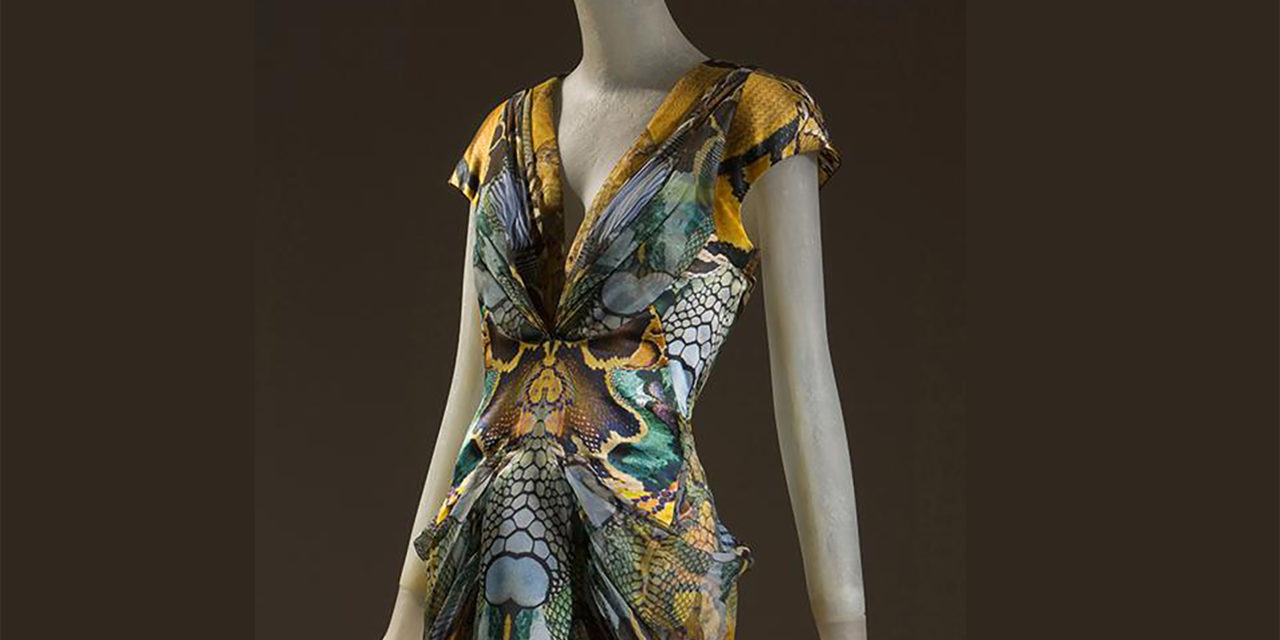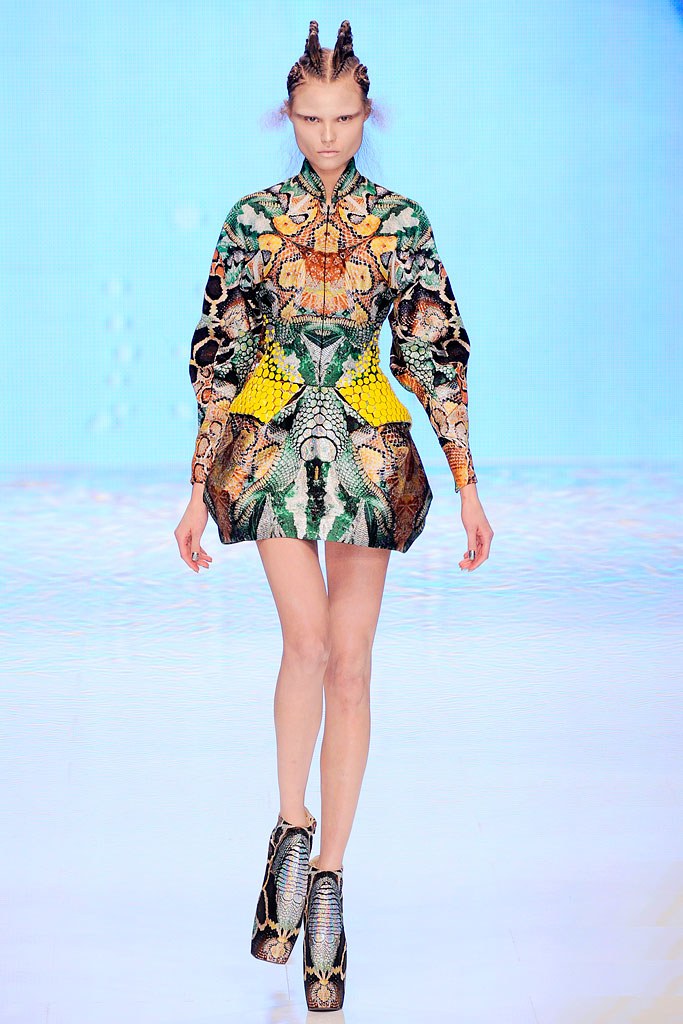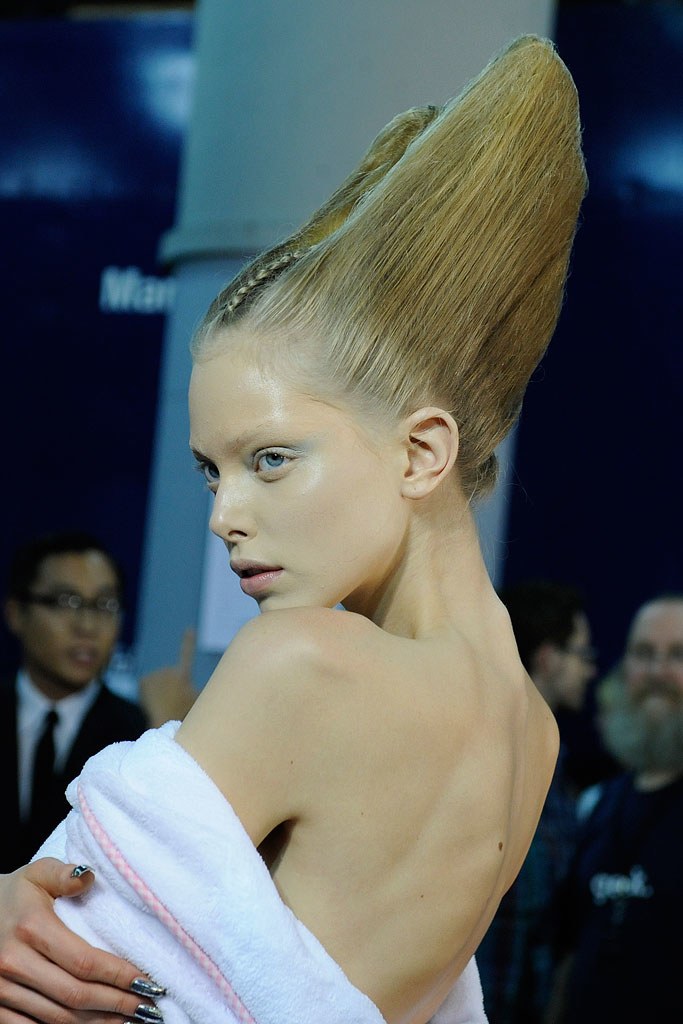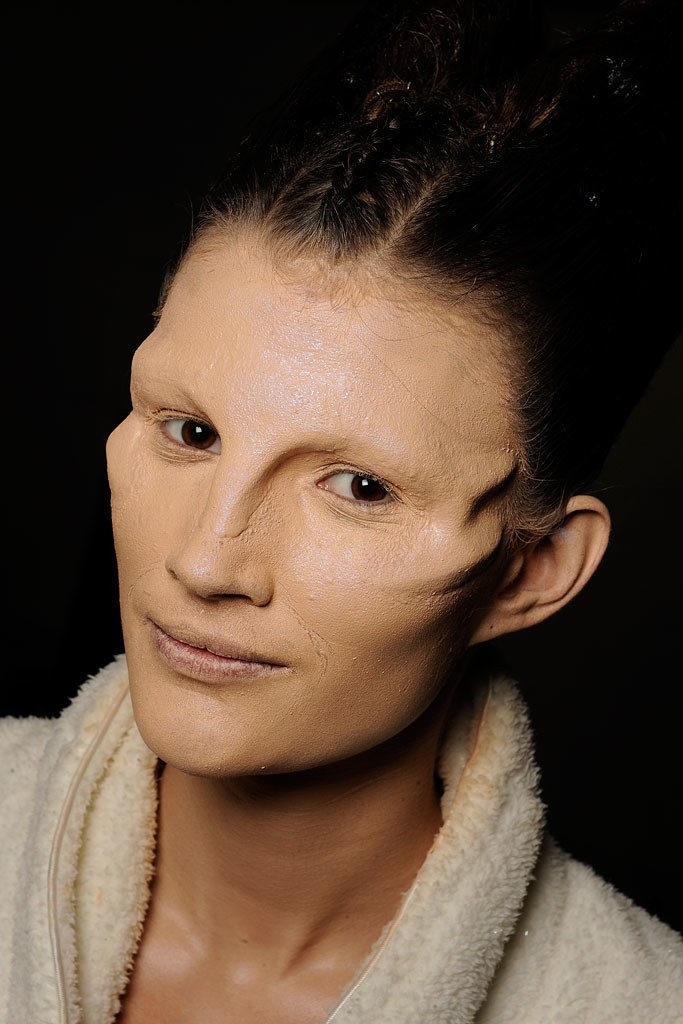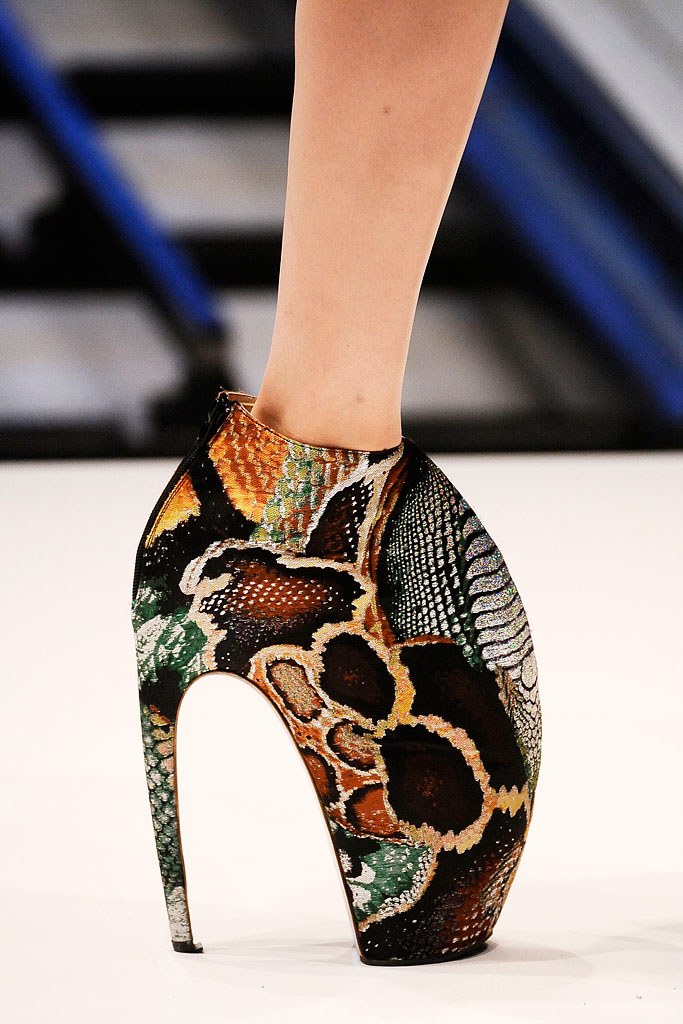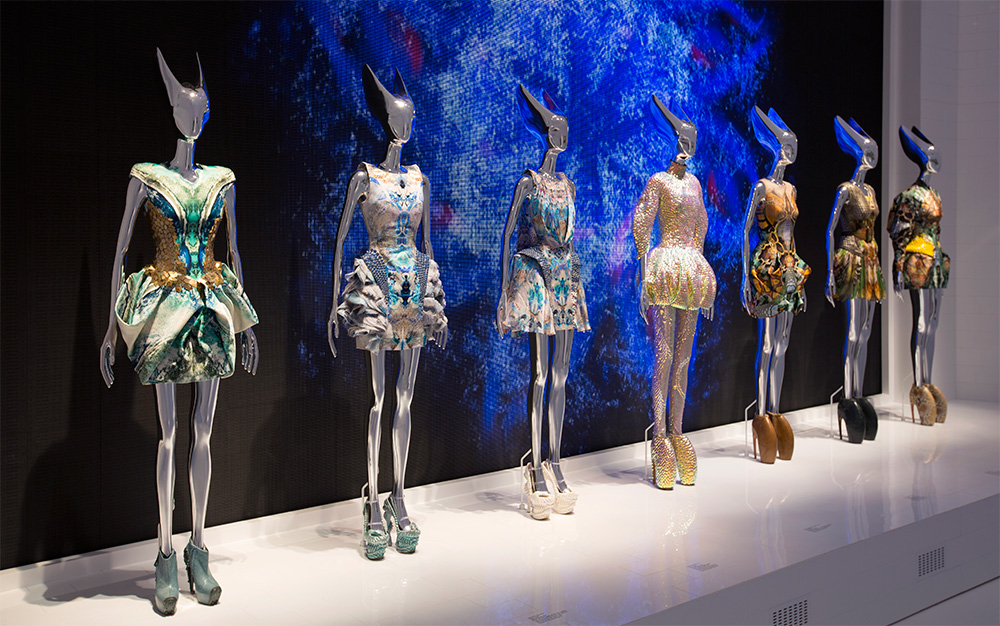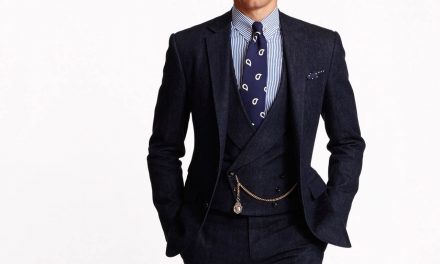This Alexander McQueen ready-to-wear S/S 2010 dress used digital printing and creativity to set new standards in the fashion industry.
ABOUT THE LOOK
On October 6th, 2009, Paris’s 12th arrondissement indoor arena became the venue for Alexander McQueen’s Spring/Summer 2010 ready-to-wear show titled Plato’s Atlantis. This dress, which is constructed of multi-color printed silk satin and chiffon, was featured. The dress has short sleeves and is pleated and ruched around the hips, creating an organic shape that enhances the body. The multi-color silk satin and chiffon has a fusion of different printed reconstructed reptile skins as seen in figure 1. As the Museum at FIT explains, the show
“envisioned a future of human reversion to an animal state, with computer-generated imagery suggesting reptilian markings.”
Fig. 1 - Alexander McQueen (British, 1969-2010). Dress, 2010. New York: The Museum at FIT. Source: MFIT
Alexander McQueen (British, 1969-2010). Dress, Spring/Summer 2010 Ready-to-Wear. Multi-color printed silk satin and chiffon. New York: The Museum at FIT, 2010.77.1. Museum purchase. Source: The Museum at FIT
About the context
Kathrine Gleason and Simon Collins explain McQueen’s interpretation of Plato’s Atlantis in their book Alexander McQueen: Evolution (2012):
“Foreseeing a time when the polar ice caps have melted and the seas have risen, McQueen predicts a future in which humans, with the aid of bio-engineering, reverse evolution and return to the sea from which life came. “Plato’s Atlantis,” the title of the show, refers to the legendary island described by the classical Greek philosopher as having sunk beneath the sea. McQueen explains that this show is based on fantasy, myth, and legend.” (205)
The beginning of the runway show started with a video made by Nick Night featuring model Raquel Zimmerman laying nude with snakes moving across her body. The video then shifted to a collage of different snake-like reptiles–a pattern similar to the one featured on the garments seen in figure 2.
Fig. 2 - Alexander McQueen (British, 1969-2010). Alexander McQueen S/S 2010 Runway Show, 2009. Source: WWD
Fig. 3 - Alexander McQueen (British, 1969-2010). Alexander McQueen S/S 2010 Runway Show, 2009. Source: Dazed Digital
The runway itself was a white reflective tile with two huge cameras tracking the models and projecting what they were recording on the screen. The cameras also showed the audience members on the screen right before the first look came down the runway. The reaction to McQueen’s collection was astounding as the first look come down the runway (Fig. 3). The shapes and silhouettes were never-before-seen in Alexander McQueen’s previous collections. Sarah Mower idiscussed n Vogue Runway how the McQueen show came together as one collection:
“McQueen’s message throughout was essentially sunk into the short dress—a steady development of his engineered sea-reptile prints, worked into a nipped-waist, belled-skirt silhouette. The colors—first green and brown, moving to aqua and blue—were exceptionally executed and swagged, and molded across panniered structures. Each dress was a work of computer-generated art crossbred with McQueen’s couture-based signature cut.” (Vogue Runway)
Each outfit kept the theme of the collection anchored. The makeup and hair helped advance the story and theme. The hair was constructed like large fins on the models’ head which combined with braids going down the middle of the models’ heads (Fig. 4). The braids gave a sense of texture, just like the digital prints on the dress (Fig. 5). The makeup used was colorless; the models looked as if their faces were wet and glistening. Some models had on prosthetic makeup making them look fish-like in line with the theme that they are now living underwater with gills (Fig. 6). McQueen introduced a new type of shoe called the armadillo which was 12 inches high and created a kind of armor over the models’ feet (Fig. 7).
Plato’s Atlantis was a show far ahead of its time. McQueen was one of the first to use 3D-printing as a part of his show; for example, the shoes in figure 8 are 3D-printed. The show was also one of the first to live-stream the collection, allowing people not present to watch. Emma Hope Allwood writes about how livestreaming affected the fashion industry:
“It had such a seismic effect on the industry. I think everybody realized, ‘Hold on, wait a minute. Instead of showing this show to three hundred people, we can show it to six million?’ It was like a bomb going off, there was such a huge ripple-effect through every part of the industry afterwards. All the studios and all the companies go, ‘Hold on, wait a minute, I can get through to six million people with my show, I don’t have to think of an advertising campaign… why aren’t we putting everything into a show that can get through to so many people?’” ( Dazed Digital)
Fig. 4 - Alexander McQueen (British, 1969-2010). Hair, S/S 2010. Source: Vogue Runway
Fig. 5 - Alexander McQueen (British, 1969-2010). Hair, S/S 2010. Source: Vogue Runway
Fig. 6 - Alexander Mcqueen (British, 1969-2010). MakeUp, S/S 2010. Source: Vogue Runway
Fig. 7 - Alexander McQueen (British, 1969-2010). Armadillo Shoe, S/S 2010. Source: Vogue Runway
Fig. 8 - Alexander McQueen (British, 1969-2010). Shoes, S/S 2010. Source: Vogue Runway
Its Afterlife
The show still is talked about today as it was one that changed the fashion industry and since it was the last complete collection designed by Alexander McQueen before his tragic death. Rosemary Feitelberg interviewed Robert Fairer for Women’s Wear Daily (WWD) and Fairer spoke about the show:
“The spring 2010 Plato’s Atlantis collection is still out-of-this-world. No one since has attempted to implement where those new silhouettes could go, but much of the easier digital printing techniques have been copied relentlessly since it showed.” (WWD)
This dress along with many of the garments in the same collection have been featured in many museum exhibitions; perhaps most famously, the Metropolitan Museum of Art’s “Savage Beauty,” McQueen retrospective, which also traveled to the Victoria & Albert Museum (Fig. 9).
Fig. 9 - Photographer unknown. "Savage Beauty", 2015. London: Victoria and Albert Museum. Source: V&A
References:
- “Alexander McQueen Spring 2010 Ready-to-Wear Collection – Vogue.” Vogue. Accessed February 27, 2019. https://www.vogue.com/fashion-shows/spring-2010-ready-to-wear/alexander-mcqueen#coverage.
- Allwood, Emma Hope. “The McQueen Show That Changed the Future of Fashion.” Dazed Digital. August 02, 2016. Accessed March 06, 2019. http://www.dazeddigital.com/fashion/article/32285/1/the-mcqueen-show-that-changed-the-future-of-fashion-platos-atlantis-nick-knight
- Feitelberg, Rosemary. “Rare Alexander McQueen Backstage Photos Revealed.” WWD. February 13, 2017. Accessed March 06, 2019. https://wwd.com/eye/people/alexander-mcqueen-unseen-backstage-photos-robert-fairer-book-10698468/.
- Gleason, Katherine, and Simon Collins. Alexander McQueen: Evolution. New York, N.Y: Race Point, 2012. http://www.worldcat.org/oclc/1083066487
- “The Museum at FIT – Online Collections.” Accessed February 27, 2019. http://fashionmuseum.fitnyc.edu/view/objects/asitem/search$0040/2/dynasty-desc?t:state:flow=78c4faac-1d02-436f-b997-6f8961c0abd3.

